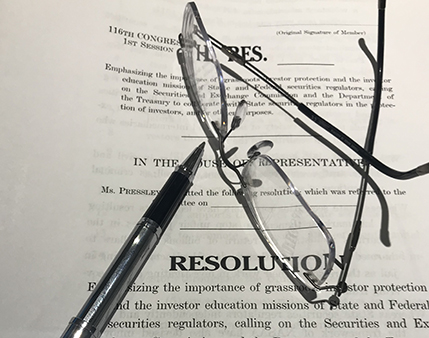Report calls on firms to fully disclose risks, screen customers better
Regulators urged to step up enforcement, explicitly ban lending schemes
Independent analysis finds that at least 70% of traders lose money and only 11.5% might profitably trade
WASHINGTON (August 9, 1999) – State securities regulators today issued a report based on a seven-month investigation of the day trading industry. The report, the first of its kind, catalogued problems encountered in the day trading industry, including misleading marketing, lax supervision and highly questionable loan schemes.
The report concluded by calling on day trading firms to do a better job of screening potential customers and disclosing the substantial risks of day trading. The 46-page report urged all securities regulators to step up inspection of day trading firms and, where appropriate, bring more enforcement actions.
The report also contained an independent analysis of a sampling of accounts at a day trading firm, All-Tech Investment Group, which found that 70 percent of customers lost money. The consultant, Ronald L. Johnson of Palm Harbor, Florida, concluded “70% of public traders will not only lose, but will almost certainly lose everything they invest.” Further, “Only 11.5% of the sample evidenced the ability to conduct profitable short-term trading.”
“State securities regulators have found troubling trends at the day trading firms and branch offices we’ve looked at–problems with marketing, suitability, loan arrangements, supervision, and traders trading other people’s money,” said Peter C. Hildreth, New Hampshire’s director of securities regulation and president of the North American Securities Administrators Association (NASAA), the group that commissioned the task force’s work.
Hildreth added: “If day trading firms want to become part of the mainstream, they need to play by the same rules the rest of Wall Street follows. If they don’t get their act together they will be under increasing regulatory pressure.”
There are no independent estimates on the number of day traders. The report quoted an estimate by the Electronic Traders Association, an industry group, that there are 4,000-5,000 active day traders. The report said regulators have identified 62 firms and 286 branch offices, where day traders sometimes make dozens of trades a day, hoping to capitalize on small movements in the price of stocks.
Day trading is different from online investing. Millions of Americans have online brokerage accounts with firms such as Charles Schwab, Fidelity, Ameritrade and E*Trade, placing buy and sell orders, usually from home, on their personal computers. By contrast, day traders typically trade at specialty day trading firms, using proprietary software. Day traders have more immediate access to the market than those with online accounts and often pay higher commissions.
Last December the NASAA board of directors established a task force [The Day Trading Project Group] to look into day trading, after several states, notably Massachusetts and Texas, took enforcement actions against firms in their jurisdictions.
The report criticized some of the marketing by day trading firms as misleading, saying it exaggerated the potential profits and downplayed the risks. According to the report, All-Tech Investment Group, one of the largest day trading firms, suggested that day trading could “become a mainstream career choice.”
On its web site All-Tech claimed:
Electronic Day Trading appeals to executives, victims of downsizing or lay-off, retirees, graduating college students and anyone who recognizes the unlimited earnings potential and quality of life which an Electronic Day Trader may achieve. Trading allows people to work a 6 ½ hour trading day, to take vacations on demand and to leave for the day on a whim.
The report said the day trading industry has refused requests by state securities regulators for information to back up claims of profitability. In one case, regulators learned that in a day trading branch office in Massachusetts, 67 of 68 accounts had lost money.
As part of its work the NASAA Day Trading Project Group hired an independent analyst, Johnson, to study a representative sample of accounts at All-Tech’s Massachusetts branch office, the subject of a December 1998 enforcement action and subsequent settlement. Johnson concluded that “only one of the customers successfully day traded, and this account did not realize returns commensurate with the risks.”
NASAA supported a rule, approved July 29 by the board of the National Association of Securities Dealers (NASD) that would require day trading firms to more rigorously screen customers and be more forthright about the risks of day trading. NASAA urged the SEC to speedily approve the NASD rule.
The report said day trading firms have a great need for customers and the commissions they generate, to cover their high capital and operating costs, estimated at $30,000 per customer by the president of Momentum Securities, a leading day trading firm.
To hold on to customers and the commissions they generate, some firms promote and arrange inter-customer loans to help them meet margin calls, according to the report. The report called on the NASD to explicitly ban such lending practices to prevent customers from trading beyond their means.
In addition, the report said, customers are sometimes encouraged to get money from third parties in order to trade. State regulators believe such practices might require that the trader register as an investment adviser.
Day trading firms have glamorized day trading, said David Shellenberger, chief of licensing at the Massachusetts Securities Division, chair of the task force and the report’s primary author. “Day trading isn’t investing, it’s at best speculating. Most traders will lose all of their money.”
Added NASAA Executive Director Philip A. Feigin, who as Colorado Securities Commissioner last year imposed tight restrictions on two day trading firms operating in his jurisdiction: “If you absolutely positively want to day trade, you should only play with money you can afford to lose. People need to remember that this isn’t video games and Monopoly money.”
NASAA President Hildreth emphasized that regulators don’t have problems with technology or day trading per se. “Day trading has been around for a long time, long before the personal computer. Investors can and should use the latest technology. It has helped level the playing field between Wall Street and Main Street. But the rules of the game are the same as ever—you don’t rich quickly on Wall Street, you get rich slowly. We need to educate today’s investors and tomorrow’s investors that they need to do their homework, be disciplined and, most of all, be patient.”












